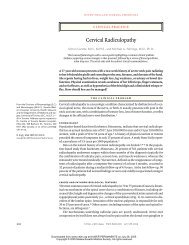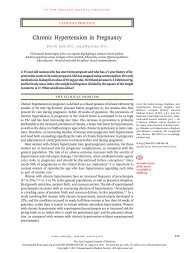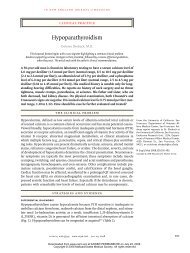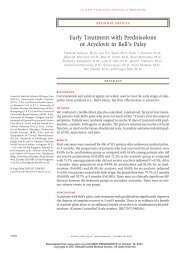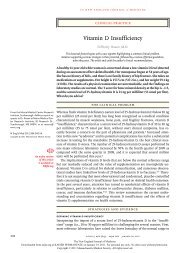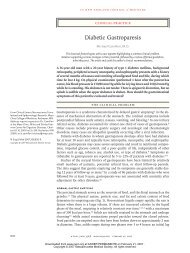Drug-Induced Immune Thrombocytopenia - Q-Notes for Adult Medicine
Drug-Induced Immune Thrombocytopenia - Q-Notes for Adult Medicine
Drug-Induced Immune Thrombocytopenia - Q-Notes for Adult Medicine
Create successful ePaper yourself
Turn your PDF publications into a flip-book with our unique Google optimized e-Paper software.
current concepts<br />
H<br />
<strong>Drug</strong>-dependent<br />
antibody CDR<br />
+<br />
<strong>Drug</strong><br />
H<br />
+<br />
H<br />
<strong>Drug</strong>-dependent<br />
antibody CDR<br />
+<br />
+<br />
+<br />
+<br />
Platelet antigen<br />
Low-affinity fit<br />
Platelet antigen<br />
High-affinity fit<br />
Figure 2. Model <strong>for</strong> the Binding of a <strong>Drug</strong>-Dependent Antibody to an Epitope on a Platelet Glycoprotein.<br />
COLOR FIGURE<br />
Antibodies capable of causing drug-dependent thrombocytopenia react weakly with an epitope on a target glycoprotein. The binding affinity<br />
Draft 5 06/15/07<br />
(K A ) <strong>for</strong> this interaction is too low to allow a sufficient number of antibody molecules to bind in the absence of the drug (“low-affinity<br />
Author Aster<br />
fit”). The drug contains structural elements that are complementary to a negatively charged site on the glycoprotein<br />
Fig #<br />
and a hydrophobic<br />
2<br />
site (H) on the complementarity-determining region (CDR) of the antibody. The drug interacts with these sites to Title improve <strong>Drug</strong>-dependent the fit between<br />
antibody binding<br />
the two proteins, increasing the K A to a value that permits binding to occur at levels of antibody, antigen, and ME drug achieved in the circulation<br />
after ingestion of the drug (“high-affinity fit”). Adapted from Bougie et al. 37<br />
DE<br />
Artist<br />
Campion<br />
KMK<br />
AUTHOR PLEASE NOTE:<br />
Figure has been redrawn and type has been reset<br />
Please check carefully<br />
Platelet-specific autoimmunity induced by drugs<br />
is clinically similar to acute idiopathic autoimmune<br />
thrombocytopenia. 43 The possibility that<br />
drug-induced autoimmune thrombocytopenia is<br />
not uncommon remains speculative.<br />
Di agnosis<br />
<strong>Drug</strong>-induced thrombocytopenia should be suspected<br />
in any patient who presents with acute<br />
thrombocytopenia of unknown cause. In considering<br />
this diagnosis, the clinician should keep in<br />
mind that 5 to 7 days of exposure is usually needed<br />
to produce sensitization in a patient given a<br />
drug <strong>for</strong> the first time. As previously noted, platelet<br />
inhibitors are exceptions to this general rule.<br />
In adults, the presence of severe thrombocytopenia<br />
(






